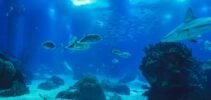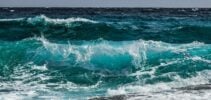This new international treaty signed in New York, the first intended to protect and regulate the exploitation of biodiversity navy of areas that do not belong to any national jurisdiction, is essential to conserving at least 30% of the world's land and oceans by 2030.
ADVERTISING
Currently, only 1% of international waters – a gigantic expanse that represents around half the planet and more than 60% of the oceans – are protected.
And this even after science has proven the importance of protecting all these oceans with an often microscopic biodiversity, which provides half of the oxygen we breathe and limits climate warming by absorbing an important part of the CO2 generated by human activity.
Oceans in danger
O high seas begins where the so-called Exclusive Economic Zones (EEZ) of countries end, which reach a maximum of 200 nautical miles (370 km) from their respective coasts.
ADVERTISING
The approved text recognizes the need to “coherently and cooperatively address the loss of biodiversity and degradation of ocean ecosystems, due in particular to the impact of climate change on marine ecosystems“, such as warming waters, loss of oxygen, acidification, plastic contamination and overfishing.
When it comes into force, after being ratified by a minimum of 60 countries, the Conference of the Parties (COP), – a decision-making body that brings together the signatory States –, will be able to create specific marine areas in international waters for the protection, the care and responsible use of marine biological resources, as well as the subsoil, defined as “the Zone”.
These sanctuaries located in particularly fragile or important areas for endangered species are the most emblematic point of the future treaty. Until now, countries could create these protected areas in their own territorial waters.
ADVERTISING
The warning from NGOs
The COP will have to define how to apply its decisions together with other global and regional organizations that currently have authority over parts of the ocean.
In particular, regional fisheries organizations and the International Seabed Authority (ISA), which currently oversees licenses for deep-sea mining exploration in some areas and may make the controversial decision to allow companies to start mining, warn NGOs.
While most COP decisions are consensual to avoid blockades of one country or a small group of countries, signatories have agreed that far-reaching measures, such as the creation of marine sanctuaries, can be approved by a three-quarters majority of members. gifts.
ADVERTISING
Military activities, in turn, are left out of the treaty, as are fishing activities, which are regulated by other legal instruments.
What the text does not provide is how conservation measures will be controlled. Some experts propose using satellites for monitoring.
Marine genetic resources
Each country, coastal or not, and every entity under its jurisdiction, may carry out, on the high seas, collection of plants, animals and microorganisms, whose genetic material may be used, including commercially., for example, by pharmaceutical companies hoping to discover miracle molecules.
ADVERTISING
So that developing countries, which do not have the means to finance costly research, do not find themselves deprived of their piece of a pie that belongs to no one, the text provides for the principle of sharing benefits in a “fair and equitable” manner.
Besides, a mechanism will be created to financially assist developing countries to implement the agreement, which will be fueled by annual contributions from members and the benefits arising from the use of marine genetic resources and the sequencing of genetic resources in international waters.
The COP will decide the modalities for sharing these economic benefits. This was one of the imbroglios between North and South.
In general, the text provides support for developing countries through the transfer of technology and the strengthening of their research capabilities, as well as the creation of a “free access platform” to share information.
Furthermore, access to traditional knowledge associated with marine genetic resources in international waters in the hands of indigenous peoples and local communities must first have their express consent.
Impact studies
The treaty creates the principle of obligation that, before receiving authorization, studies are carried out on the impact on the environment of the activities contemplated..
It also urges countries to carry out studies on the impact on international waters of activities carried out in waters under their jurisdiction and which may contaminate or damage the marine environment.
The modalities for consultation and such studies will be developed by a future scientific and technical body dependent on the COP.
In case of disputes, the parties will have to resolve them by “peaceful means” of their “own choice”, which in the case of technical differences, may be resolved by a panel of experts constituted by the said parties.
(To AFP)
@curtonews UN member countries signed an unprecedented treaty to protect the oceans. This historic landmark provides for conservation measures. #CurtoNews #AltoMar ♬ original sound – Curto News
Read also






